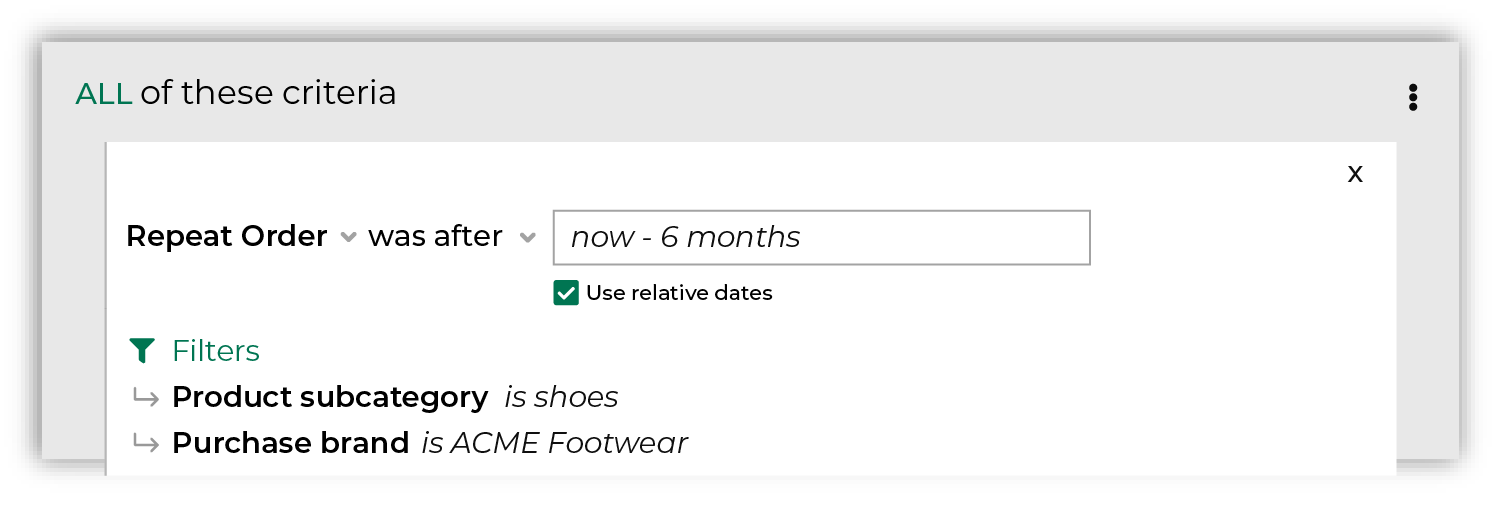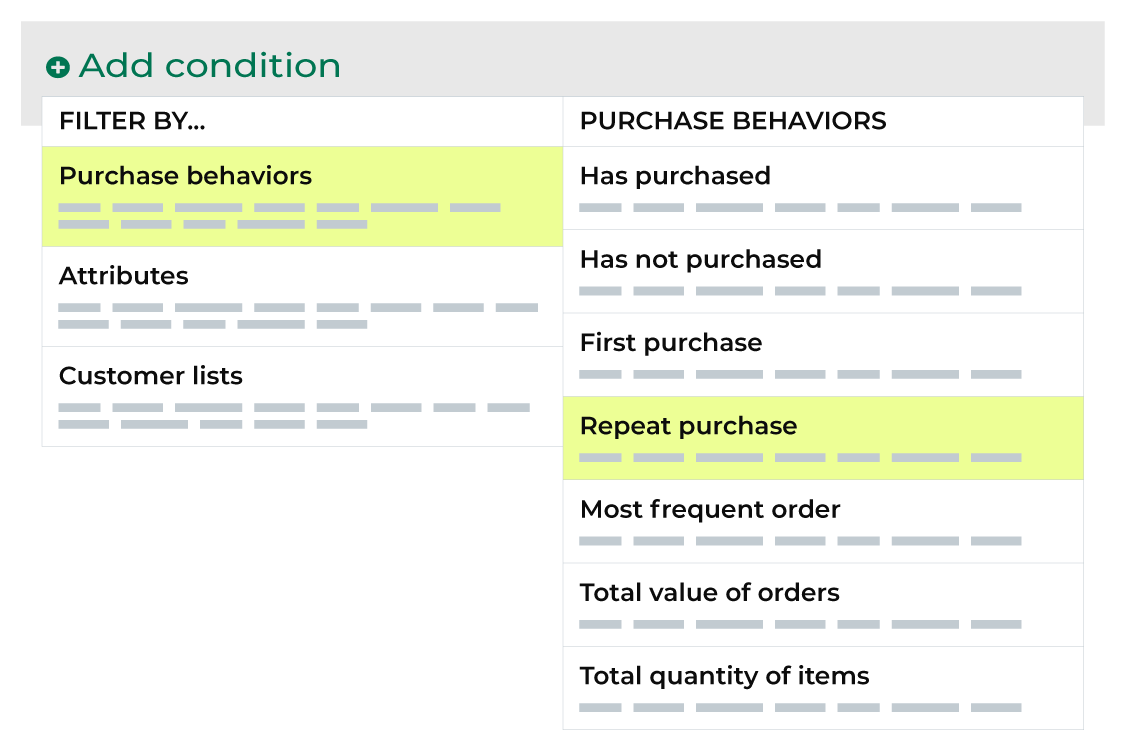Repeat purchase¶
Repeat purchase returns a list of customers who have made a repeat purchase during the chosen date range. For example, return all customers who made a repeat purchase within the previous 6 months:

Important
Repeat purchase identifies a repeat purchase by comparing purchases within the chosen date range to all purchases. For example, a customer who first purchased 2 years ago, and then purchased again last month would be returned by a relative date range “today - 1 month”. A customer who first purchased 10 years ago, and then purchased again last month would also be returned. As well as a customer who first purchased 2 months ago, and then purchased again last month.
After you specify a date range you may apply filters to associate repeat orders to specific products, brands, channels, and stores. For example, return all customers who made a repeat purchase of shoes from your ACME Footwear brand.
How this attribute works¶
Repeat purchase represents a common approach people use when they build segments: find customers who have purchased more than one time within a time window, and then associate those customers to specific products and brands.
Repeat purchase is a compound attribute, which means that it is built from a combination of attributes that already exist in your data, and then appears as a single attribute that you can choose from the Segment Editor.
With this attribute, you can focus less on SQL and more on finding answers that align to your marketing goals and strategies. Purchase behavior attributes simplify the number of steps that are required to associate a list of customers to your products, stores, channels, and brands.
How does the SQL for Repeat Order work?
Repeat purchase is built from standard columns that are output by Amperity. The following example returns a list of customers who have purchased at least one component of a game during the previous 3 years:

The SQL for Repeat purchase works like this. It uses two common table expressions (CTEs) to find two lists: a list of first orders and a list of distinct orders.
To build the list of first orders, Repeat purchase uses order datetime from the Unified Itemized Transactions table as its starting point:
SELECT
amperity_id
,order_datetime AS first_order_datetime
,RANK() OVER (PARTITION BY amperity_id ORDER BY order_datetime, order_id) AS order_rank
FROM Unified_Itemized_Transactions
then uses the RANK() function to identify which of those orders were repeat orders, and then returns all items that match two conditions: order rank and a date range:
WHERE order_rank = 1
AND order_datetime < DATE_TRUNC('day', CURRENT_TIMESTAMP - interval '36' month)
This returns the first order for all customers who purchased during the previous 3 years.
Returns and cancellations are filtered out automatically, like this:
AND (is_return IS NULL OR (NOT is_return))
AND (is_cancellation IS NULL OR (NOT is_cancellation))
To build the list of distinct orders, Repeat purchase uses order datetime from the Unified Itemized Transactions table to find all of the distinct orders that were made during the same time period:
SELECT DISTINCT
uit.amperity_id
FROM (
SELECT
amperity_id
,order_datetime AS distinct_order_datetime
FROM Unified_Itemized_Transactions
)
To identify which customers made a repeat purchase during this time window, the first order CTE is joined to the distinct order CTE:
INNER JOIN first_order_datetime
ON distinct_order_datetime
(Note that “first_order_datetime” and “distinct_order_datetime” names do not represent the real names of the CTEs that are joined. These names identify the two sources that are joined together as part of the steps within the SQL that identify your repeat customers.)
Returns and cancellations are then filtered out automatically, like this:
AND (
is_return IS NULL
OR (NOT is_return)
)
You may then filter this list of customers more by applying any of the product, purchase, and store filters. When you select these filters, they are added to the WHERE statement, like this:
AND product_category = 'game'
AND product_subcategory IN ('base', 'expansion', 'pack')
AND purchase_brand = 'Fearless Creatures'
The SQL for Repeat purchase is more complex than what is described in the previous section. This is due to the way this attribute returns only a list of Amperity IDs, uses a series of common table expressions (CTEs), and takes advantage of workflows that Amperity does behind the scenes to pre-filter the product, purchase, and store attributes.
You can view the full SQL for Repeat purchase from the Segment Editor. Start a new segment and add only this attribute (along with any required conditions and filter attributes), and then click the View SQL link at the top of the page.
Add to segments¶
You can add the Repeat purchase behavior to a segment from the Segment Editor. Click Add condition, choose Purchase behaviors, and then select Repeat purchase.

After the Repeat purchase behavior attribute has been added, select an operator, and then finish defining the conditions for how this attribute should be applied to the segment.
About relative dates¶
A relative date is determined at the time a segment is run, where today is the day on which the segment is run. For example: yesterday, 30 days ago, 14 days ago, or 1 year ago. The list of relative date values includes a series of common ranges, but you may also type in a more specific range, such as 2 months ago or 5 days ago.
Relative date values
Value |
Description |
|---|---|
Tomorrow |
Starts at 12:00:00 AM of the day after the current day. For example, if the current day is “Thursday 01 / 12 / 2023” then tomorrow is “Friday 01 / 13 / 2023”. |
Today |
Starts at 12:00:00 AM or at the current time on the current day and continues for 24 hours. For example, if the current day is “Thursday 01 / 12 / 2023” then today is “Thursday 01 / 12 / 2023”. |
Yesterday |
Starts at 12:00:00 AM of the day before the current day. For example, if the current day is “Thursday 01 / 12 / 2023” then yesterday is “Wednesday 01 / 11 / 2023”. |
N days ago |
Starts at 12:00:00 AM of the day N days before the current day. For example, if the current day is “Thursday 01 / 12 / 2023”, then:
|
1 month ago |
Starts at 12:00:00 AM of the same day of the month that is 1 month before the current month. For example, if the current day is “Thursday 01 / 12 / 2023” then 1 month ago is “Monday 12 / 12 / 2022”. |
1 year ago |
Starts at 12:00:00 AM of same day of the year that is 1 year before the current year. For example, if the current day is “Thursday 01 / 12 / 2023” then 1 year ago is “Wednesday 01 / 12 / 2022”. |
Tip
You can compare segments by % of Purchasers, % of Revenue, or Revenue/Purchaser by changing the option in the Compare by: field.
Available operators¶
The following table lists the operators that are available to this attribute.
Note
Recommended operators for this attribute are identified with “ More useful” and operators with more limited use cases are identified with “ Less useful”.
Condition |
Description |
|---|---|
was after |
More useful Returns a list of customers where repeat purchases were after the specified time window. |
was before |
More useful Returns a list of customers where repeat purchases were before the specified time window. |
was between |
More useful Returns a list of customers where repeat purchases were between two specified time windows. |
was not between |
Less useful Returns a list of customers where repeat purchases were not between two specified time windows. |
was not on |
Less useful Returns a list of customers where repeat purchases were not on the specified date. |
was on |
Returns a list of customers where repeat purchases were on the specified date. |
Filter attributes¶
A filter attribute is a standard column that is output by Amperity and is available from the Unified Itemized Transactions table. When a filter attribute is associated with a purchase behavior attribute, you may use them to filter the results by specific items in your product catalog, such as by brand, by channel, by store, or by specific details about the items in your product catalog, such as color or SKU. The list of filter attributes that will be available for product catalogs depends on their availability within your Unified Itemized Transactions table.